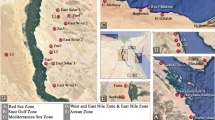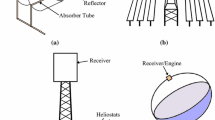Abstract
Clean renewable electric power technologies are important in human life, a great number of thermal solar power plants with different configurations are being considered for deployment all over the world. In this work, we propose a feasibility study of concentrated solar power plant to be set up in different sites of Algeria. It is essential that the plant design will be optimized to each specific location. Among the CSP technologies, we will emphasize on the Fresnel solar power plants at different areas of Algerian Sahara. These areas have been chosen for comparison by shifting the plant to different locations; namely Hassi R’mel, Tamanrasset, Beni-Abbes, and El Oued. Direct Normal Irradiance (DNI), solar field surface, block number, the block surface, block panels’ number, absorber surface, and finally thermal power losses in the absorber are the key parameters for optimization and performance evaluation. The calculation results have been depicted for each site. Indeed, the calculation of performance varies from one site to another with DNI mean values of 788.4, 698.7, 671.7, and 636 W/m2, respectively for Tamanrasset, Beni-Abbes, El Oued and Hassi R’mel sites. The surface of solar field, block number, absorber surface and power loss have been also evaluated for the same sites.
You have full access to this open access chapter, Download conference paper PDF
Similar content being viewed by others
Keywords
- Solar energy
- Solar concentrator mirrors
- Fresnel solar thermal power plants
- Performance
- Thermoelectric plants
3.1 Introduction
It is universally acknowledged that two of the key technological and economic challenges of the 21st century are energy and environment [1]. Consequently, considerable efforts are being made to effect a gradual transition from systems based on fossil fuels to those based on renewable energy (RE). Electricity generation from solar energy is currently one of the main research areas in the field of renewable energy. In the case of Algeria; the newly adopted version of the National Renewable Energy Program offers the country the possibility to integrate 27% of renewable energy in the national energy mix. Preservation of fossil re-sources; diversification of electricity production and contribution to sustainable development are among challenges that face the country nowadays [2]. It is recognized that solar-thermal energy can play a useful role in generating electrical power despite concerns regarding cost as the thermal source is accessible and ubiquitous [3]. The use of linear Fresnel solar power plant for electricity production, or heat supply is one of the most attractive solutions for developing countries with high sunshine because of the accessible level of technology involved [4].
In this study, our main purpose is to describe Fresnel concentrator solar plant characteristics, through defining its different performances, so that influence of changing location and climatic conditions can be seen on plant cost-effectiveness and productivity for each location i.e. Hassi R’mel, Beni-Abbes, El Oued, and Tamanrasset for Central, West, East and South of Algeria respectively.
3.2 Plant Description
The solar power plant chosen for this study is a 5 MW electric Fresnel concentrator plant which is technically similar to the German Novatec solar plant set up in Calasparra site in Spain (same make and model) (Fig. 3.1).
The design parameters of the power plant are shown in Table 3.1 (Novatec solar) [5].
3.3 Specification
In this section, we have drawn up a specification in which plant characteristics, namely Direct Normal Irradiance (DNI), solar field surface, block number, have been defined (it should be noted that a block contains reflecting mirrors, absorber tube, and steam separator). We have also defined the block surface, block panels’ number, absorber surface, and finally thermal power losses in the absorber.
-
A. Sizing calculation
The generator output power is equal to: Pg = 5 MWelectric.
In order to supply a small city of 5000 inhabitants, whose daily consumption is 5 kWh per family of electricity, each family is composed of 5 persons.
-
B. Distribution of powers per activity
Polyclinic = 0.2 MW, factory = 1 MW, Administration = 0.5 MW, other = 0.3 MW. The sum is 2 MW, so it remains 3 MW for inhabitants: this is the peak power needed by these places.
Therefore, inhabitants number = 1000 houses, or: x = 1000 * 5 = 5000 people
So, the consumption of the city is 5 MWe, it is distributed as follows:
-
Polyclinic = 0.2 MW
-
Factory = 1 MW
-
Administration = 0.5 MW
-
Inhabitants = 3 MW
-
Others = 0.3 MW
The solar multiple is taken as equal to 1.6 which corresponds to 1.5 h of storage.
The selected locations are:
-
West → Beni-Abbes
-
Center → Hassi R’Mel
-
East → El Oued
-
South → Tamanrasset
Table 3.2 represents site meteorological data.
-
C. Calculation of plant characteristics
-
DNIavg calculation (direct normal irradiance)
= 698.7 W/m2 for Beni-Abbes and the same calculation is done for the other locations.
-
Calculation of power
P = P1 + P2 = SM * P1, with SM is the solar multiple = 1.6
P = 1.6 * 14.28 = 22.84 MWthermal
So: P2 = 22.84 − 14.28 = 8.56 MWthermal
All efficiencies and powers are shown in Table 3.3.
-
Calculation of field surface for each location
If receiver efficiency = 85% we will obtain: Optical efficiency = 45%
So, global efficiency is obtained:
\(\eta_{\text{global}} = \frac{p}{{A*{\text{DNI}}}} \Rightarrow A = \frac{P}{{n_{g} *{\text{DNI}}}} = \frac{{22.84 \times 10^{3} }}{0.38*0.698} = 86,000\;{\text{m}}^{2}\)
For Beni-Abbes, and the same calculation is done for the other locations.
“A” represents field surface.
-
Calculation of block number and surface of each block
The size of (Novatec) plant solar field is S = 21,571 m2
This plant contains 2 blocks, each block has a power of 0.7 MW electric
\(\frac{A}{S} = \frac{{86{,}000}}{{21{,}571}} = 3.98\) is the number of block for a power of 0.7 MW electric
\(3.98*2 = 8\,{\text{blocks}}\) is the number of block for a power of 1.4 MW electric
“A” is the block surface.
The surface of a block is given by:
\(A = \frac{{86{,}000}}{8} = 10{,}750\,{\text{m}}^{2}\) for Beni-Abbes and the same calculation is done for the other locations.
-
Calculation of actual absorber surface
Absorber unit surface is: L * D
L represents unit length = 44.8 m, D represents receiver diameter = 0.6 m
Aabs; unit = 44.8 * 0.6 = 26.88 m2
Each block contains a unit whose surface is 513.6 m2
So: Aabs actual = Number of units multiplied by unit absorber surface.
= 21 * 26.88 = 564.48 m2 is the absorber surface in a 0.7 MW block.
Total surface of absorbers is calculated by multiplying the result of block number by the actual absorber surface.
STotal = 8 * 564.48 = 4515.8 m2 for Beni-Abbes and the same calculation is done for the other locations.
-
Calculation of lost power
Ploss = UL * Aabs actual * ΔT
We have: Tin = 140 °C, Toutput = 270 °C, UL = 5 W/m2 °C
Ploss = 5 * 4515.8 * 130 = 2.93 * 106 W for Beni-Abbes and the same calculation is done for the other locations. Final results are shown in Table 3.4
3.4 Results Analysis
As a comparison, we want to check the results found in the first part, then validate them through drawing up specifications in which different plant performances are defined, while using a global calculation method. These performances have been calculated, through using a DNI calculated on the basis of annual normal irradiation ratio to sunshine hours. We propose to verify hereafter these results with those found by SAM simulation software [7]. Simulation of energy performance is carried out in another study using a SAM simulation software, as well as the techno-economic study [8]. A comparative study is made while taking a representative day of the year (21st June, the longest/hottest), we took the DNI values, and then recalculate the power output to adjust the results for each site.
The results are shown in Table 3.5.
M1 shown in the table depicts the first calculation method (the global method set forth in the specifications). According, this comparative study aiming at the verification of the results obtained in the global method with those calculated by SAM simulation software, we notice that the output power varies from 4.74 to 5.43 MW, so we can see that there is a slight difference between powers calculated by both methods, and according to the calculations show a difference of less than 8%. The results found by the global method used for the cases studied here are quite satisfactory.
3.5 Conclusion
The study we carried out on Linear Fresnel Concentrator Solar Power Plant allowed us to understand the operating system of this type of plant, as well as the parameters affecting its operation and performances. We have also noticed that the blocking and shadowing effects between mirrors and the cosine effect represent a great obstacle for the power plant cost-effectiveness and productivity. According to this study, we were able to notice the importance of a good choice of the power plant site, as each site is characterized by its direct radiation, ambient temperature, sunshine hours, wind speed, latitude, height above sea level, and other factors which play a key role in the power plant cost-effectiveness and productivity. This is clearly shown in the results obtained according to which the plant different parameters and characteristics vary when it is shifted in different sites.
According to the results obtained for the plant different characteristics in the 4 sites, we can see that Algeria has great opportunities to choose this kind technology i.e. linear Fresnel concentrator solar power plant.
Finally, we can conclude that, among the above-mentioned sites, the most suitable on performance basis is Tamanrasset followed by Beni-Abbes, then El Oued, and finally Hassi R’mel.
References
R.E. Smalley, Future global energy prosperity: the terawatt challenge. MRS Bull. 30, 412–417 (2005)
S. Mihoub, A. Chermiti, H. Beltagy, Methodology of determining the optimum performances of future concentrating solar thermal power plants in Algeria. Energy Int. J. 122, 801–810 (2017)
B. Srimanickam, M.M. Vijayalakshmi, E. Natarajan, Experimental performance assessment of single glazing flat plate solar photovoltaic thermal (PV/T) hybrid system. Prog. Ind. Ecol. Int. J. 9(2), 111–120 (2015)
H. Beltagy, D. Semmar, L. Christophe, N. Said, Theoretical and experimental performance analysis of a Fresnel type solar concentrator. Renew. Energy Int. J. 101, 782–793 (2017)
http://www.Novatecsolar.com
ONM/ Office National de la Météorologie, ministère des transports, Algeria
http://www.Nrel.Gov/Analysis/Sam
H. Beltagy, D. Semmar, N. Said, Performance of medium-power Fresnel Concentrator solar plant in Algerian sites. Energy Procedia 74(2015), 942–995 (2015)
Acknowledgements
The authors are grateful to Dr. Said Noureddine from CDER (Renewable Energy Development Center, Algeria) for his constant guidance and critical review in improving the manuscript.
Author information
Authors and Affiliations
Corresponding author
Editor information
Editors and Affiliations
Rights and permissions
<SimplePara><Emphasis Type="Bold">Open Access</Emphasis> This chapter is licensed under the terms of the Creative Commons Attribution 4.0 International License (http://creativecommons.org/licenses/by/4.0/), which permits use, sharing, adaptation, distribution and reproduction in any medium or format, as long as you give appropriate credit to the original author(s) and the source, provide a link to the Creative Commons license and indicate if changes were made.</SimplePara> <SimplePara>The images or other third party material in this book are included in the book's Creative Commons license, unless indicated otherwise in a credit line to the material. If material is not included in the book's Creative Commons license and your intended use is not permitted by statutory regulation or exceeds the permitted use, you will need to obtain permission directly from the copyright holder.</SimplePara>
Copyright information
© 2018 The Author(s)
About this paper
Cite this paper
Beltagy, H., Mihoub, S., Semmar, D., Said, N. (2018). Feasibility Study of Linear Fresnel Solar Thermal Power Plant in Algeria. In: Mpholo, M., Steuerwald, D., Kukeera, T. (eds) Africa-EU Renewable Energy Research and Innovation Symposium 2018 (RERIS 2018). RERIS 2018. Springer Proceedings in Energy. Springer, Cham. https://doi.org/10.1007/978-3-319-93438-9_3
Download citation
DOI: https://doi.org/10.1007/978-3-319-93438-9_3
Published:
Publisher Name: Springer, Cham
Print ISBN: 978-3-319-93437-2
Online ISBN: 978-3-319-93438-9
eBook Packages: EnergyEnergy (R0)





